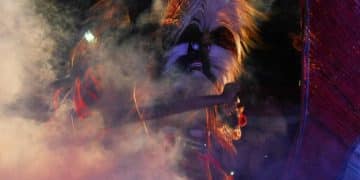Crossover Thrash: Exploring the Hardcore Punk & Thrash Metal Fusion

Crossover thrash is a subgenre of thrash metal that combines hardcore punk and thrash metal, resulting in fast tempos, aggressive vocals, and a blend of punk and metal aesthetics.
Crossover thrash is where hardcore punk’s raw energy slams headfirst into thrash metal’s blistering speed and aggression. Prepare to dive into the chaotic world where circle pits meet mosh pits, and shredding guitars scream alongside guttural vocals.
What is Crossover Thrash?
Crossover thrash emerged in the early to mid-1980s as a rebellious fusion of two distinct yet complementary musical styles. Hardcore punk provided the DIY ethics, short, fast songs, and politically charged lyrics, while thrash metal contributed technical guitar work, complex song structures, and a more metallic sound.
The result was a genre that was both intensely aggressive and irresistibly energetic, appealing to fans of both punk and metal scenes. Bands began experimenting with incorporating elements of both genres, leading to the birth of a new sound that was heavier than punk and faster than metal.
Origins and Influences
The roots of crossover thrash can be traced back to the early 1980s when bands like Black Flag and Suicidal Tendencies started incorporating heavier, more metal-influenced sounds into their punk music. Simultaneously, thrash metal bands like Metallica and Slayer were influenced by the speed and aggression of hardcore punk.
This cross-pollination of ideas and sounds led to the emergence of bands that fully embraced the fusion of both genres. These pioneers laid the foundation for what would become known as crossover thrash, blending the best aspects of both worlds.
Key Characteristics
Crossover thrash is characterized by its blistering speed, aggressive vocals, and a blend of punk and metal aesthetics. The songs are usually short and to the point, rarely exceeding three minutes in length. Lyrical themes often revolve around social commentary, politics, and personal angst.
- Fast Tempos: Crossover thrash songs are known for their breakneck speed, often exceeding 200 beats per minute, creating an intense and frenetic energy.
- Aggressive Vocals: Vocal styles range from hardcore punk shouts and barks to thrash metal’s more guttural and aggressive delivery, reflecting the genre’s blended heritage.
- Punk and Metal Aesthetics: The visual presentation of crossover thrash bands often includes elements from both punk and metal cultures, such as ripped clothing, band t-shirts, and long hair.
- Lyrical Themes: Lyrical content often tackles social issues, political themes, and personal struggles, reflecting the DIY and rebellious spirit of both punk and metal.
In essence, crossover thrash is a high-octane musical experience that captures the raw energy and rebellious spirit of both hardcore punk and thrash metal, creating a sound that is both familiar and refreshingly unique.
The Rise of Crossover Thrash Bands
As crossover thrash began to take shape, several bands emerged as key players in defining and popularizing the genre. These groups combined the raw energy of hardcore punk with the technical prowess of thrash metal, resulting in a sound that was both aggressive and innovative.
These bands not only pushed the boundaries of both genres but also attracted a dedicated following within the punk and metal communities, solidifying crossover thrash as a distinct and influential subgenre.

Notable Bands
Several bands stand out as pioneers and innovators in the crossover thrash scene. These groups not only defined the sound of the genre but also helped to popularize it among both punk and metal fans.
- D.R.I. (Dirty Rotten Imbeciles): Often credited as one of the first crossover thrash bands, D.R.I. combined hardcore punk aggression with thrash metal speed, creating a sound that was both raw and technically impressive.
- Suicidal Tendencies: While initially a hardcore punk band, Suicidal Tendencies incorporated more metal elements into their sound over time, eventually becoming a prominent crossover thrash act with albums like “How Will I Laugh Tomorrow When I Can’t Even Smile Today.”
- Stormtroopers of Death (S.O.D.): A side project of Anthrax guitarist Scott Ian, S.O.D. blended thrash metal with hardcore punk’s brevity and irreverence, creating a sound that was both humorous and intensely aggressive.
- Cryptic Slaughter: Hailing from California, Cryptic Slaughter was known for their technical musicianship and politically charged lyrics, contributing significantly to the crossover thrash movement.
These bands helped to shape the sound and identity of crossover thrash, influencing countless other musicians and solidifying the genre’s place in the history of punk and metal.
Key Albums That Defined the Genre
Several albums stand out as seminal works that not only defined the sound of crossover thrash but also helped to popularize it among a wider audience. These records showcased the genre’s unique blend of hardcore punk and thrash metal, demonstrating its potential for creativity and aggression.
These albums not only influenced countless musicians but also continue to be celebrated by fans of both punk and metal, solidifying their place in the history of crossover thrash.
Essential Listening
These albums represent the pinnacle of crossover thrash, showcasing the genre’s unique blend of punk and metal influences. Each record offers a distinct perspective on the genre, highlighting its diversity and creative potential.
- D.R.I. – “Dealing With It!”: This album is a quintessential crossover thrash record, featuring blistering speed, aggressive vocals, and socially conscious lyrics.
- Suicidal Tendencies – “How Will I Laugh Tomorrow When I Can’t Even Smile Today”: This album showcases the band’s transition from hardcore punk to crossover thrash, with more complex song structures and technical guitar work.
- S.O.D. – “Speak English or Die”: This album is a humorous and ultra-aggressive take on crossover thrash, featuring short, fast songs that blend thrash metal with hardcore punk’s irreverence.
- Cryptic Slaughter – “Money Talks”: This album is known for its technical musicianship and politically charged lyrics, offering a more sophisticated take on the crossover thrash sound.
These albums are essential listening for anyone interested in exploring the crossover thrash genre, providing a comprehensive overview of its key characteristics and influential bands.
The Influence of Crossover Thrash on Other Genres
Crossover thrash, despite its relatively short lifespan as a distinct subgenre, has had a significant impact on the broader landscape of punk and metal music. Its fusion of hardcore punk and thrash metal elements has influenced numerous bands and genres, contributing to the evolution of extreme music.
The genre’s emphasis on speed, aggression, and lyrical content has resonated with musicians across a variety of styles, solidifying its place as an important part of the underground music scene.

Impact on Modern Music
Crossover thrash’s influence can be heard in a variety of modern metal and punk subgenres. Its emphasis on speed and aggression has been adopted by bands in genres such as grindcore and powerviolence, while its lyrical focus on social issues has resonated with politically charged punk bands.
Additionally, the DIY ethic and rebellious spirit of crossover thrash have inspired countless musicians to create their own unique sounds, pushing the boundaries of extreme music and challenging conventional genre definitions.
Notable Examples
Several bands and genres have been directly influenced by crossover thrash, incorporating its key elements into their own unique styles. These examples demonstrate the genre’s lasting impact on the broader music scene.
- Grindcore: Bands like Napalm Death and Brutal Truth have taken the speed and aggression of crossover thrash to even more extreme levels, creating a sound that is both chaotic and intensely powerful.
- Powerviolence: This subgenre of hardcore punk is heavily influenced by crossover thrash, emphasizing short, fast songs with politically charged lyrics and a raw, unpolished sound.
- Modern Thrash Metal: Many contemporary thrash metal bands have incorporated elements of crossover thrash into their music, such as faster tempos and more aggressive vocals, creating a sound that is both familiar and innovative.
By pushing the boundaries of punk and metal, crossover thrash has helped to pave the way for new and exciting musical styles, leaving a lasting legacy on the underground music scene.
The Decline and Resurgence of Crossover Thrash
Like many subgenres, crossover thrash experienced a period of decline in popularity during the late 1980s and early 1990s. As musical tastes shifted and new styles emerged, the genre lost some of its momentum, with many bands either disbanding or evolving their sound in different directions.
However, in recent years, there has been a resurgence of interest in crossover thrash, with new bands emerging and older acts reuniting to celebrate the genre’s legacy. This revival has been fueled by a renewed appreciation for the energy, aggression, and DIY ethic that defined crossover thrash in its heyday.
Factors Contributing to the Decline
Several factors contributed to the decline of crossover thrash in the late 1980s and early 1990s. These included:
- Shifting Musical Tastes: As new genres like grunge and alternative rock gained popularity, many fans of extreme music turned their attention away from crossover thrash.
- Band Breakups and Lineup Changes: Several key crossover thrash bands disbanded or experienced lineup changes, leading to a decline in the genre’s overall visibility.
- Lack of Mainstream Support: Crossover thrash never achieved mainstream success, remaining a largely underground phenomenon.
The Modern Revival
Despite its decline, crossover thrash has experienced a significant revival in recent years. This resurgence can be attributed to:
| 🤘 New Bands | Emergence of bands blending punk and metal. | 🔥 Reunions | Classic crossover bands reunite. | 🌐 Online Communities | Internet fosters fan base. | 🎶 Festivals | Showcasing crossover thrash bands. |
FAQ
What is Crossover Thrash?
▼
Crossover thrash melds hardcore punk’s intensity and thrash metal’s complexity into a fierce, energetic subgenre. It’s known for fast tempos, aggressive vocals, and the DIY spirit of both punk and metal.
What are the key characteristics of Crossover Thrash?
▼
Fast tempos, aggressive vocals, punk and metal aesthetics, and lyrical themes centered on social commentary, politics, and personal struggles define crossover thrash. Its songs often don’t exceed three minutes.
How did Crossover Thrash influence other genres?
▼
Crossover thrash has impacted genres like grindcore, powerviolence, and modern thrash metal. These genres incorporated its speed, aggression, and lyrical themes, furthering the influence of crossover sound.
What are some of the most influential bands of Crossover Thrash?
▼
D.R.I., Suicidal Tendencies, S.O.D., and Cryptic Slaughter are the most influential Crossover Thrash bands of the subgenre during the 80s.
What are the essential Crossover Thrash albums to listen to?
▼
To grasp Crossover Thrash in its entirety, here are a few albums that shaped the genre: “Dealing With It!” by D.R.I., “How Will I Laugh Tomorrow When I Can’t Even Smile Today” by Suicidal Tendencies, and “Speak English or Die” by S.O.D.
Conclusion
Crossover thrash stands as a testament to the power of musical fusion, blending the intensity of hardcore punk with the technical prowess of thrash metal. From its emergence in the 1980s to its modern resurgence, the genre has left a mark on the history of extreme music, influencing countless bands and inspiring fans with its energy, aggression, and DIY spirit.
Read more content





